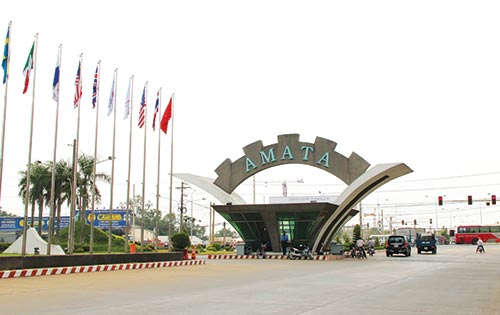Amata pleas for extra incentives
 Amata will pursue its request for special incentives despite the fact that the Vietnamese government looks unlikely to grant it Photo: Le Toan |
The Thai industrial developer claimed that such incentives would be necessary to compete with surrounding industrial parks (IPs) such as VSIP Haiphong and Dinh Vu.
Somhatai Panichewa, president of Amata (Vietnam) JSC, the developer of the Amata Bien Hoa industrial complex, and CEO of Amata VN Plc., which is listed on Thailand’s stock exchange, and the developer of all future projects in Vietnam, held a meeting last week with Minister of Planning and Investment Bui Quang Vinh to put forward the request.
Under the proposal, Amata requested that the normal incentive rate for corporate income tax (CIT) of 10 per cent be extended over 18 years, with the first five years fully exempt, 5 per cent paid over the next eleven years, and 10 per cent paid over the final two years of this period. In addition, it requested an 8 per cent CIT for hi-tech companies for the entirety of the project’s lifetime, and reducing by half the personal income tax (PIT) rate for people working in the site. Amata also asked for an exemption on their land and water rental fees.
Amata’s requested incentive far exceeds the existing preferential incentives that the Vietnamese government granted to companies investing in the country’s economic zones (EZs). Currently, EZ businesses enjoy the highest incentives in the country, with a 10 per cent CIT over a 15 year period, with the first four years exempt and the following nine years at a 50 per cent reduction.
Under the legal regulations on tax incentives for IP projects, companies investing in Amata’s future projects can get only two years of tax exemption and four years of a 50 per cent reduction. There is no PIT reduction for employees in IPs.
Panichewa explained that Amata asked for this support package from the Vietnamese government because it wished to increase its competitiveness against VSIP Haiphong – which is situated only 16 kilometres from the proposed Amata site, and which is a part of the Dinh Vu EZ in the northern port city of Haiphong.
She affirmed Amata was determined to pursue this project.
Amata has been investing in Vietnam since 1994, with the maiden project of Amata Bien Hoa, in the southern province of Dong Nai. Two years ago, it proposed to develop the project in Quang Yen district in Quang Ninh, on a 6,400 hectare site. This area includes industrial land, education and science facilities, as well as logistics and exhibition facilities.
Amata estimated that this project would create 300,000 jobs and attract around $5 billion in investments from foreign and domestic companies.
At the meeting, Minister of Planning and Investment Bui Quang Vinh said that the incentive request was beyond the authority of the government. As tax incentives are regulated by laws such as the Law on Corporate Income Tax and the Law on Investment, only the National Assembly can amend them.
“Amata’s project is just an IP. We cannot provide more incentives to companies investing there. If Amata wishes to have more incentives, it must establish an EZ and prove its feasibility as well as explain the effectiveness of the zone,” said Vinh, adding that this measure was also likely an impossible task because most of EZs already in existence throughout the country had a wealth of space yet to be filled.
Vinh cited the case of Rent-A-Port, which had been refused by the government when seeking the highest incentive rate for its newly-licensed IP also in Quang Ninh.

